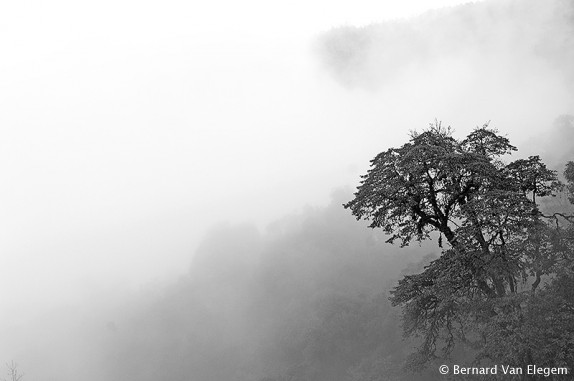- 1 of 5
- next
Mountain rainforest wrapped in the clouds - Bergregenwoud gehuld in de wolken
Eaglenest Wildlife Sanctuary is located in the West Kameng District, which lies in the Western part of Arunachal Pradesh. The Park is part of a huge pristine area on the border of Assam and Arunachal Pradesh, which is called the Kameng Protected Area Complex, which is an Elephant Reserve. South of Eaglenest, lies Nameri and more to the East, Sessa Orchid Wildlife Sanctuary and Pakhui Tiger Reserve conjoin the park. It is one of the most biodiverse regions of South Asia, where species of the Brahamputra plains meet the foothills and where vast pristine forest tracts are found from altitudes of a few hundred metres above sealevel till about 3500 metres above sealevel. Further North high alpine scrub, meadows and rocky areas are found at altitudes above 4000 metres. The Eastern Himalays are characterised by very steep slopes and a very high annual rainfall, which explains the very lush vegetation in Eaglenest. We visited the park at the end of the dry season, when the rains starts to be more frequent. This is the best time of the year for song and territorial activity of the birds. As the vegetation is very dense and many skulking bird specialities occur within the part, it is advisable to visit Eaglenest during march - april. Later on, the rains start to get more frequent and heavier, and it becomes risky to visit the park, because of frequent road damage. The Park holds an amazing number of large mammals: Elephants are very common, and Gaur, Sambar, Black Bear, Leopard and Tiger are also found within the Park. A lot of much sought after and rare bird species are found within Eaglenest, such as the Rufous-Necked Hornbill, Ward's Trogon, Beautifull Nuthtach, Greater and Lesser Rufous-headed Parrotbills, and Fire-tailed Myzornis. No less then 8 species of Wren-babblers are found in the park, of which the Sikkim Wedge-billed Wren-babler has the most restricted range. The Park became internationally famous, when a spectatcular new bird species to science was described in 2006 by Ramana Athreya: the Bugun Liocichla. The bird, a laughing trush species, was named after the local tribe of the Bugun People, who live in the park. We spent a total of 15 days in the park. Here we are in Lama Camp, at an elevation of about 2350 metres above sealevel, and where we spent three full days. The area around Lama Camp, holds more pristine forest towards the Eaglenest Pass, and more degraded forest at the lower elevations. A little bit below the Camp there is a Bugun village. Especially the areas around the Bugun village, with secondary forest en dense shrubs and tangled vines in cleared areas, are the best spot to observe the secretive Bugun Liocichla. Some of the other bird specialities in the surroundings of Lama Camp are Rufous-throated Wren-babbler (common) and Spotted Wren-babbler, Orange-headed Bullfinch, Ward's Trogon and Yellow-rumped Honeyguide (rare and seldom observed).

